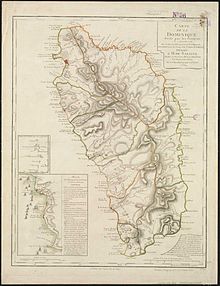The first written records in the history of Dominica began in November 1493, when Christopher Columbus spotted the island. Prior to European contact, Dominica was inhabited by the Arawak. Dominica was a French colony from 1715 until the end of the Seven Years' War in 1763, and then became a British colony from 1763 to 1978. It became an independent nation in 1978.

Roseau is the capital and largest city of Dominica, with a population of 16,571 as of 2023. It is a small and compact urban settlement, in the Saint George parish and surrounded by the Caribbean Sea, the Roseau River and Morne Bruce. Built on the site of the ancient Island Carib village of Sairi, it is the oldest and most important urban settlement on the island of Dominica.

Diamond Rock is a 175-metre-high (574 ft) basalt island located south of "Grande Anse du Diamant" before arriving from the south at Fort-de-France, the main port of the Caribbean island of Martinique. The uninhabited island is about 3 kilometres (1.9 mi) from Pointe Diamant.

The Battle of Grenada took place on 6 July 1779 during the American Revolutionary War in the West Indies between the British Royal Navy and the French Navy, just off the coast of Grenada. The British fleet of Admiral John Byron had sailed in an attempt to relieve Grenada, which the French forces of the Comte D'Estaing had just captured.

The Battle of St. Lucia or the Battle of the Cul de Sac was a naval battle fought off the island of St. Lucia in the West Indies during the American Revolutionary War on 15 December 1778, between the British Royal Navy and the French Navy.

Scotts Head is a village on the southwest coast of Dominica, in Saint Mark Parish. In 2001, its population was 721. Predominantly a fishing village, Scotts Head overlooks Soufrière Bay, which is protected as the Soufrière Scotts Head Marine Reserve. It is also a popular snorkeling and diving site for tourists.

Dominica officially the Commonwealth of Dominica, is an island country in the Caribbean. The capital, Roseau, is located on the western side of the island. It is geographically situated as part of the Windward Islands chain in the Lesser Antilles archipelago in the Caribbean Sea. Dominica's closest neighbours are two constituent territories of the European Union, the overseas departments of France, Guadeloupe to the northwest and Martinique to the south-southeast. Dominica comprises a land area of 750 km2 (290 sq mi), and the highest point is Morne Diablotins, at 1,447 m (4,747 ft) in elevation. Its population was 71,293 at the 2011 census.
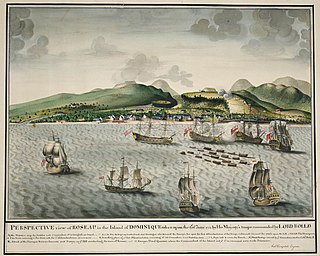
The Invasion of Dominica was a British military expedition to capture the Caribbean island of Dominica in June 1761, as part of the Seven Years' War.
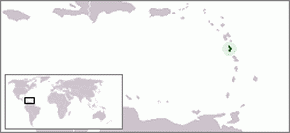
The following is an alphabetical list of topics related to the nation of Dominica.

The invasion of Martinique was a successful British amphibious operation against the French colony of Martinique that took place between 30 January and 24 February 1809 during the West Indies campaign of 1804–1810 of the Napoleonic Wars. Martinique, like the nearby island of Guadeloupe, was a major threat to Britain's trade in the West Indies, providing a sheltered base from which privateers and French Navy warships could raid British merchant shipping and disrupt the trade routes that maintained the economy of the United Kingdom. Both islands also provided a focus for larger-scale French operations in the region and in the autumn of 1808, following the Spanish alliance with Britain, the Admiralty decided to order a British squadron to neutralise the threat, beginning with Martinique.
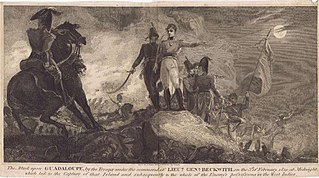
The Invasion of Guadeloupe was a British amphibious operation fought between 28 January and 6 February 1810 over control of the Caribbean island of Guadeloupe during the Napoleonic Wars. The island was the final remaining French colony in the Americas, following the systematic invasion and capture of the others during 1809 by British forces. During the Napoleonic Wars, the French colonies had provided protected harbours for French privateers and warships, which could prey on the numerous British trade routes in the Caribbean and then return to the colonies before British warships could react. In response, the British instituted a blockade of the islands, stationing ships off every port and seizing any vessel that tried to enter or leave. With trade and communication made dangerous by the British blockade squadrons, the economies and morale of the French colonies began to collapse, and in the summer of 1808 desperate messages were sent to France requesting help.

The Invasion of Tobago was a French invasion of the British-held island of Tobago during the Anglo-French War. On May 24, 1781, the fleet of Comte de Grasse landed troops on the island under the command of General Marquis de Bouillé. By June 2, 1781, they had successfully gained control of the island.
The Capture of Saint Vincent was a French invasion that took place between 16 and 18 June 1779 during the American Revolutionary War. A French force commander named Charles-Marie de Trolong du Rumain landed on the island of Saint Vincent in the West Indies and quickly took over much of the British-controlled part of the island, assisted by local Black Caribs who held the northern part of the island.
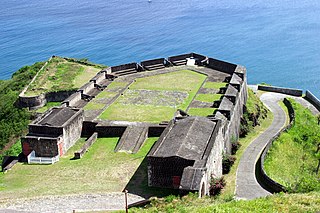
The French invasion of Saint Kitts also known as the siege of Brimstone Hill, from 19 January–13 February 1782, was a part of the American Revolutionary War. After landing on Saint Kitts, the French troops of the Marquis de Bouillé stormed and besieged the fortress of Brimstone Hill. After a month of battle, the heavily outnumbered and cut-off British garrison surrendered. The Comte de Grasse, who delivered de Bouillé's troops and supported the siege, was outmanoeuvred and deprived of his anchorage by Admiral Samuel Hood. Even though Hood's force was inferior by one-third, de Grasse was beaten off when he attempted to dislodge Hood. Hood's attempts to relieve the ongoing siege were unsuccessful, and the garrison capitulated after one month. About a year later, the Treaty of Paris restored Saint Kitts and adjacent Nevis to British rule.

The Capture of St Lucia was the result of a campaign from 18–28 December 1778 by British land and naval forces to take over the island, which was a French colony. Britain's actions followed the capture of the British-controlled island of Dominica by French forces in a surprise invasion in September 1778. During the Battle of St. Lucia, the British fleet defeated a French fleet sent to reinforce the island. A few days later French troops were soundly defeated by British troops during the Battle of Morne de la Vigie. Realising that another British fleet would soon arrive with reinforcements, the French garrison surrendered. The remaining French troops were evacuated, and the French fleet returned to Martinique, another French colony. St. Lucia stayed in the hands of the British.
Thomas Atwood was chief justice of the island of Dominica, and afterwards of the Bahamas.

The Anglo-French War, also known as the War of 1778 or the Bourbon War in Britain, was a military conflict fought between France and Great Britain, sometimes with their respective allies, between 1778 and 1783. As a consequence, Great Britain was forced to divert resources used to fight the American War of Independence to theatres in Europe, India and the West Indies, and to rely on what turned out to be the chimera of Loyalist support in its North American operations. From 1778 to 1783, with or without their allies, France and Britain fought over dominance in the English Channel, the Mediterranean, the Indian Ocean and the Caribbean.

The Commonwealth of Dominica and the Republic of France maintain historical, political, economic, social and cultural relations. Sometimes referred to as "French Dominique", Dominica also shares close ties with its nearest neighbours, the overseas departments of the French Republic, Guadeloupe to the north and Martinique to the south. At present, Dominica is connected to the French islands by an inter-island express ferry. Under the auspice of the European Union both Dominica and France are tied economically via a 2008 concluded multilateral Economic Partnership Agreement (EPA) trade-deal representing many Caribbean nations under the name CARIFORUM. They are further members of: The Association of Caribbean States (ACS), the Caribbean Postal Union, the Organisation internationale de la Francophonie, the International Monetary Fund (IMF), the World Bank, and the United Nations.
Fort Young was a major military installation on the Caribbean island of Dominica. It was built by the British in 1770. The fort was named for William Young, the island's first British governor. Today, only ruins remain of the fort, and the site is the location of the Fort Young Hotel.

Fort Cachacrou was a historic military fortification and signal station on the island of Dominica. The fort was built by the British in the 1760s in present-day Scotts Head. During the American Revolutionary War, it was the site of the first battle in the French Invasion of Dominica. Remains of Fort Cachacrou include portions of the original walls and a canon. The site is accessible via the Waitukubuli National Trail.


